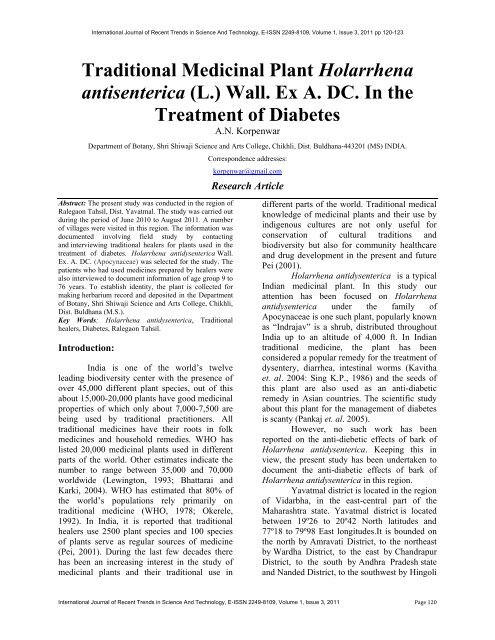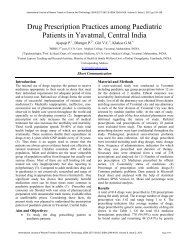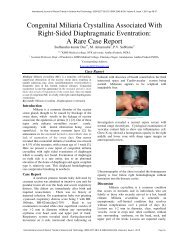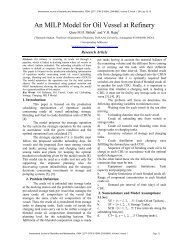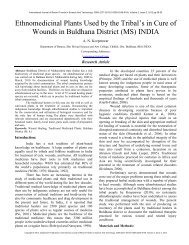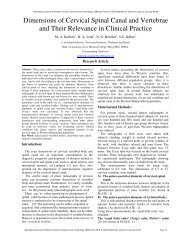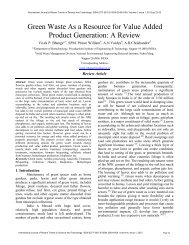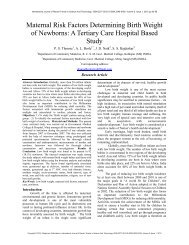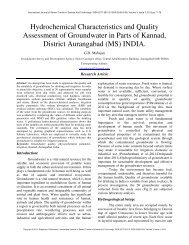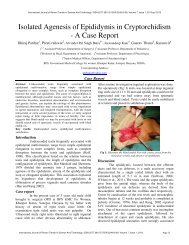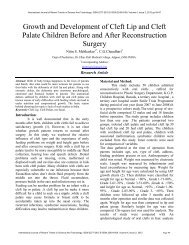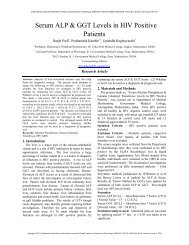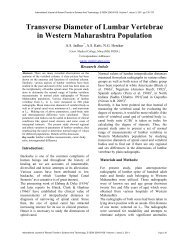Traditional Medicinal Plant Holarrhena antisenterica (L ... - Statperson
Traditional Medicinal Plant Holarrhena antisenterica (L ... - Statperson
Traditional Medicinal Plant Holarrhena antisenterica (L ... - Statperson
Create successful ePaper yourself
Turn your PDF publications into a flip-book with our unique Google optimized e-Paper software.
International Journal of Recent Trends in Science And Technology, E-ISSN 2249-8109, Volume 1, Issue 3, 2011 pp 120-123<strong>Traditional</strong> <strong>Medicinal</strong> <strong>Plant</strong> <strong>Holarrhena</strong><strong>antisenterica</strong> (L.) Wall. Ex A. DC. In theTreatment of DiabetesA.N. KorpenwarDepartment of Botany, Shri Shiwaji Science and Arts College, Chikhli, Dist. Buldhana-443201 (MS) INDIA.Correspondence addresses:korpenwar@gmail.comResearch ArticleAbstract: The present study was conducted in the region ofRalegaon Tahsil, Dist. Yavatmal. The study was carried outduring the period of June 2010 to August 2011. A numberof villages were visited in this region. The information wasdocumented involving field study by contactingand interviewing traditional healers for plants used in thetreatment of diabetes. <strong>Holarrhena</strong> antidysenterica Wall.Ex. A. DC. (Apocynaceae) was selected for the study. Thepatients who had used medicines prepared by healers werealso interviewed to document information of age group 9 to76 years. To establish identity, the plant is collected formaking herbarium record and deposited in the Departmentof Botany, Shri Shiwaji Science and Arts College, Chikhli,Dist. Buldhana (M.S.).Key Words: <strong>Holarrhena</strong> antidysenterica, <strong>Traditional</strong>healers, Diabetes, Ralegaon Tahsil.Introduction:India is one of the world’s twelveleading biodiversity center with the presence ofover 45,000 different plant species, out of thisabout 15,000-20,000 plants have good medicinalproperties of which only about 7,000-7,500 arebeing used by traditional practitioners. Alltraditional medicines have their roots in folkmedicines and household remedies. WHO haslisted 20,000 medicinal plants used in differentparts of the world. Other estimates indicate thenumber to range between 35,000 and 70,000worldwide (Lewington, 1993; Bhattarai andKarki, 2004). WHO has estimated that 80% ofthe world’s populations rely primarily ontraditional medicine (WHO, 1978; Okerele,1992). In India, it is reported that traditionalhealers use 2500 plant species and 100 speciesof plants serve as regular sources of medicine(Pei, 2001). During the last few decades therehas been an increasing interest in the study ofmedicinal plants and their traditional use indifferent parts of the world. <strong>Traditional</strong> medicalknowledge of medicinal plants and their use byindigenous cultures are not only useful forconservation of cultural traditions andbiodiversity but also for community healthcareand drug development in the present and futurePei (2001).<strong>Holarrhena</strong> antidysenterica is a typicalIndian medicinal plant. In this study ourattention has been focused on <strong>Holarrhena</strong>antidysenterica under the family ofApocynaceae is one such plant, popularly knownas “Indrajav” is a shrub, distributed throughoutIndia up to an altitude of 4,000 ft. In Indiantraditional medicine, the plant has beenconsidered a popular remedy for the treatment ofdysentery, diarrhea, intestinal worms (Kavithaet. al. 2004: Sing K.P., 1986) and the seeds ofthis plant are also used as an anti-diabeticremedy in Asian countries. The scientific studyabout this plant for the management of diabetesis scanty (Pankaj et. al. 2005).However, no such work has beenreported on the anti-diebetic effects of bark of<strong>Holarrhena</strong> antidysenterica. Keeping this inview, the present study has been undertaken todocument the anti-diabetic effects of bark of<strong>Holarrhena</strong> antidysenterica in this region.Yavatmal district is located in the regionof Vidarbha, in the east-central part of theMaharashtra state. Yavatmal district is locatedbetween 19º26 to 20º42 North latitudes and77º18 to 79º98 East longitudes.It is bounded onthe north by Amravati District, to the northeastby Wardha District, to the east by ChandrapurDistrict, to the south by Andhra Pradesh stateand Nanded District, to the southwest by HingoliInternational Journal of Recent Trends in Science And Technology, E-ISSN 2249-8109, Volume 1, Issue 3, 2011 Page 120
A.N. KorpenwarDistrict, and to the west by Washim District.The tribals invaded and localized in theRalegaon Tahsil are Gond, Kolam and Paradhan.The survey includes all the tribal ranges andnearby villages of the study area.The objective of this study was tointeract with local traditional healers anddocument their knowledge on medicinal plants,their usage and the types of diseases treated etc.As far as the Yavatmal district is concerned,meagre reports are available on the floristiccomposition and indigenous ethnomedicinalinformation present with the tribal of this area.From the foregoing account, it is clearly evidentthat, the investigations on ethnomedicinalaspects of the tribal regions of Ralegaon tahsilhave not been explored in spite of its richness inplant diversity and varied cultural practices.Material and Methods:The study was carried out in the tribalregion of Ralegaon tahsil, Dist. Yavatmal duringthe period, May 2010 to August 2011. A largenumber of places were visited in tribal localitiesof Ralegaon tahsil. The tribal villages weresurveyed through periodical tours in triballocalities. Special attention was paid to recordinformation from local Vaidyas, Hakims andtraditional herbal healers. These informants weretraditional healers themselves or had tradition ofhealing in their families and had knowledge ofthe medicinal use of the plants. The informationwas documented involving field study bycontacting and interviewing Vaidyas, Hakimsand traditional herbal healers for plants used inthe treatment of diabetes.The tribals who had used thesemedicines prepared by local ethnic medicinemenwere also interviewed to documentethnobotanical information of age group from 9to 76 years and were resident of tribal pocket inthe district. To establish identity, plants werecollected with the help of herbal healers andpractitioners for making herbarium record. Thebotanical names, vernacular names, family andmethod of treatment and mode of preparation ofdrug has been documented. The dictionary ofIndian Folk Medicines by Jain (1991), IndianMateria Medica by Nadkarni (1982) was alsoconsulted to compare with earlier reports bydifferent ethno-botanists. The presentdocumentations were not earlier reported.Voucher specimens of medicinal plantswere collected, prepared and identified. All thepreserved specimens were deposited at theDepartment of Botany, AmolakchandMahavidyalaya, Yavatmal, Dist. Yavatmal(M.S.).Observations and Result:The tribals invaded and localized in theRalegaon tahsil are Gond, Kolam and Pardhan.These tribes as per socio-religious rituals worshipnature. The ethno-medico-botanical study wasconducted to record plants used in pockets oftribal areas. As per information collected fromherbal healers and Vaidyas these plants are locallyavailable in abundance and are being used sinceancient times. The wealth of medicinal plantknowledge among the people of this tahsil isbased on hundreds of years of beliefs andobservations. This knowledge has beentransmitted orally from generation to generation;however it seems that it is vanishing from themodern society since younger people are notinterested to carry on this tradition.Tribals collect different parts of plantfor medicinal purposes. The tribals and peoples ofadjoining areas were observed suffering fromdiabetes. The medicinal plant <strong>Holarrhena</strong>antidysenterica (Fig. 2.) is the most commonlyused herb in the treatment of diabetes in thisregion is described.The dosage for control of this disease isdescribed as below:The patients suffering from diabetes curedby oral administration of 50 ml decoction of bark of<strong>Holarrhena</strong> antidysenterica twice a day beforemeals until cure. Decoction is prepared by taking 1liter water and 100 gm bark powder. The patientscured by using this treatment in different villagesare shown in Fig. 1.Copyright © 2011, <strong>Statperson</strong> Publications, International Journal of Recent Trends in Science And Technology, E-ISSN 2249-8109, Volume 1, Issue 3, 2011
A.N. KorpenwarTribals when suffered from the diabetesthey apply herbal drugs prepared by traditionalhealers. These plants are found in their localhabitat where facilities of modern hospitals donot exist. The tribal community depends fortheir medical aid on local and traditional healerexisting near habitat. The number of the patientsinterviewed in 15 villages for using these herbalmedicines in the treatment of diabetes ispresented in figures. 1.Earlier the tribals of the region wereharvesting the medicinal plants at a particulartime and date only and have belief that at thisparticular time it has more therapeutic value. Itis evident from the modern science that atparticular time the herb contains optimum activeingredients. These types of traditional harvestingpractices will be helpful in providing quality rawmaterial on sustainable basis and tool forconservation.Conclusion:The information as a outcome of studywill serve as a useful tool to botanists,pharmacologists, phytochemists, practitioners ofherbal medicine, foresters, planners andadministrators in the preparation of action anddevelopment plans for the conservation as wellas herbal drug industry in the tribal tracts forproviding self-employment opportunities andimproving and uplifting the life, economy andsocial status of the tribal and rural populations.[4] K. M. Nadkarni, “Indian Materia Medica withAyurvedic, Unani-tibbi, Siddha, allopathic,homeopathic, naturopathic & home remedies,appendicces & indexes,” Published in 1982,Popular Prakashan (Bombay), 1982.[5] K. P. Sing, “Entamoeba histolytica and<strong>Holarrhena</strong> antidysenterica, Ancient Science ofLife,” vol. 5, pp.228, 1986.[6] N. Bhattarai, M. Karki, “<strong>Medicinal</strong> and aromaticplants– Ethnobotany and conservation status,” In:J. Burley, J. Evans and J. Youngquist (Eds.).Encyclopedia of Forest Sciences. AcademicPress, London, UK. pp. 523-532, 2004.[7] N. K. Pankaj, M.Alam, B. K. Roy, “Antidiabeticactivity of seed powder of <strong>Holarrhena</strong>antidysenterica in rabbits,” J. of. Res. 17, 95-103,2005.[8] O. Okerele, “WHO Guidelines for theAssessment of Herbal Medicines,” Fitoterapia.ed. 63, vol. 2, pp. 99-110, 1992.[9] S. C. Ghose, “ Drugs of Hindoosthan,” Calcutta,Hahnemann Publishing CO Pvt. Ltd. 1998.[10] S. J. Pei, “Ethnobotanical approaches oftraditional medicine studies: Some experiencesfrom Asia,” Pharmaceutical Biology, vol. 39,pp.74-79, 2001.[11] S. K. Jain, “Dictionary of Indianfolkmedicine and ethnobotany”. Deeppublications, New Delhi,1991.[12] S. S. Katewa, B. L.Chaudhary, Anita Jain,“Folk herbal medicines from tribal area ofRajasthan, India”. Journal ofEthnopharmacology vol. 92, pp. 41–46, 2004.[13] WHO, “The Promotion and Development of<strong>Traditional</strong> Medicine,” WHO TechnicalReport Series, No. 622:8, Geneva,Switzerland, 1978.Acknowledgement:The author would like to thank traditionalhealers for providing valuable information andsupport.References:[1] Kumar, M.Ali, Fitoterapia, vol.71, pp. 101-104,2000.[2] A. Lewington, “ <strong>Medicinal</strong> plants and plantextracts: A review of their importation intoEurope.” Traffic International, Cambridge, UK,1993.[3] D. Kavitha, P.N. Shilpa, S.N. Devaraj,“Antibacterial and antidiarrhoel effects ofalkaloids of <strong>Holarrhena</strong> antidysenterica Wall,”Ind. J. Exp. Biol. , vol. 4, pp. 589-594, 2004.Copyright © 2011, <strong>Statperson</strong> Publications, International Journal of Recent Trends in Science And Technology, E-ISSN 2249-8109, Volume 1, Issue 3, 2011


